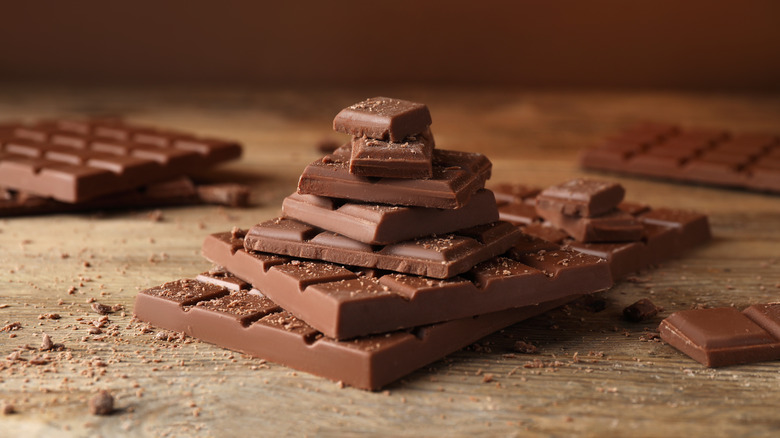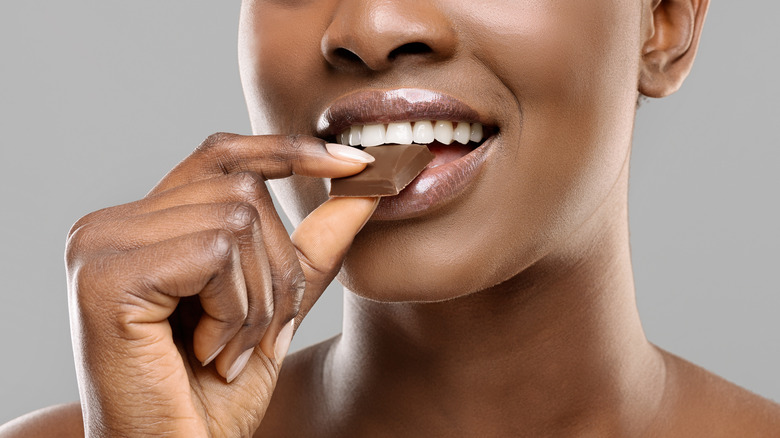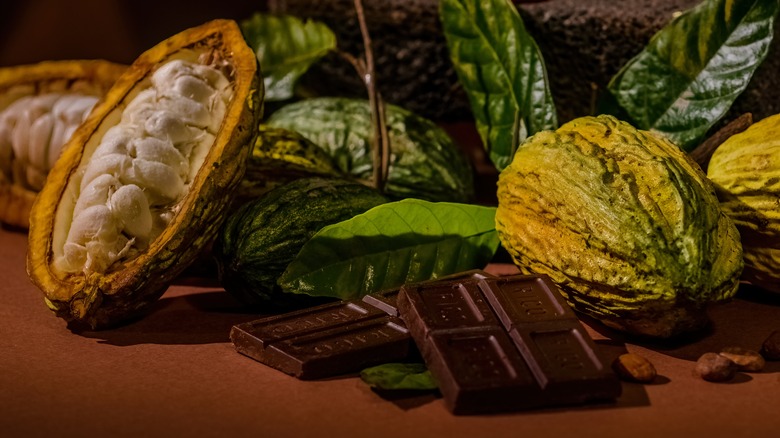How To Taste Chocolate Like A Total Connoisseur
Any chocolate lover knows that not all chocolate brands are created equal, and even the most affordable grocery store options can vary significantly in their taste and texture. Making chocolate is a true craft, and both the origin of the beans and how they are handled creates a wide range of potential flavors. There are the cocoa or nutty notes you might expect, but a good chocolate can also taste of fruit, herbs, or earth completely naturally.
With such an enticing world to explore, there's a lot to get excited about, but like with wine, it can be easy to get overwhelmed if you don't know where to start or the best ways to go about tasting chocolate. So we looked to a professional for help and asked certified chocolatier and cacao grader Preston Stewart, the director of chocolate for Onyx Coffee Lab (which is also on Instagram), for his tips on tasting chocolate like a real connoisseur.
Stewart says that the first thing any person should do is define the objective of a tasting, and he recommends starting small. Stewart told us, "One thing that I find to be most informative and easy to distinguish is a tasting with a couple craft chocolate bars versus major multinational brands (Hershey, Dove, Lindt, Ghirardelli, etc.) to show how much more flavor and nuance chocolate can have versus the one-note bitterness that's found in most grocery store brands." Beyond that, Stewart says you can try simple tastings like dark versus milk chocolate, or go more complex with different chocolate makers' versions of the same single origin chocolate.
Keep your chocolate tasting light to not overwhelm your palate
Once you know what your target is for the chocolate tasting, Stewart recommends that you organize the tasting to make sure you can easily distinguish the distinct notes of each brand and style. He gave us a range of four to six different varieties of chocolate and he warns, "More than that and you can get palate fatigue and your brain gets tired of trying to distinguish subtle characteristics." Stewart also explained that the order you taste your chocolate matters. His preferred method is to start with more bitter chocolate and work towards the sweeter, saying, "Going the other direction seems to make the chocolates seem more intense/bitter as you reduce sweetness."
In general, cleansing your palate is something Stewart considers important to chocolate tasting. "Chocolate is generally a fairly fatty product (usually 30-50% overall fat content) and the cocoa butter can coat your tongue," Stewart says. His recommendation is to use a subtle hot tea or bland cracker to reset your palate so that you can get the full experience of each chocolate. Stewart's other important note? Take your time. He told us that your mind needs to reset along with your tastebuds, as this will help you sense the unique notes of each chocolate better; there is a reason that taste is so tied to emotion and memory, after all.
Keep the focus on the chocolate and use all of your senses
While chocolate pairs wonderfully with so many different foods, Stewart suggests leaving everything else off the menu for your tasting. He says "When I'm evaluating a chocolate, I like to do so on its own and not paired with food or wine ... a pairing tasting is a completely different thing." To keep the focus on the flavor of the chocolate, he likes to break off a small piece from the bar, bite it into a few smaller pieces, and then let them melt in his mouth. What you don't want to do is "just chomp it down and devour it, you won't have time to properly evaluate it," Stewart warns.
And don't just jump into the actual eating either. Stewart says you should take chocolate in with your eyes. "Notice its color and shine," Stewart suggests, with a good shine showing that the chocolate was tempered properly. A gray or white film, on the other hand, can be proof that the temper was off, and your chocolate may be better suited to baking than eating straight. Finally, you should take in the aroma of the chocolate. Stewart explains, "Give it a smell to give your brain an idea of what flavors are coming." The world of chocolate has so much more to offer than the one-note mass-produced versions many of us know, and giving it a proper tasting can be your first window into that world.


